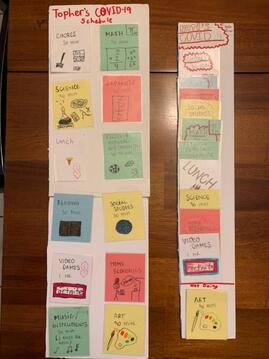 As schools have shuttered over the past few days, I’ve fielded a lot of questions from friends about what exactly they should be doing in order to help kids keep learning as we enter a phase of social distancing. The answer is that, well, like everything these days, it’s complicated. Some school districts are rolling out long-distance learning plans, while others are saying that they will provide resources for continued student learning but that these experiences are merely suggestions and not required. Regardless of the plan offered by your school district, I do have some suggestions for how to structure your child’s learning to maximize results without driving yourself crazy. Also, I have to acknowledge that the suggestions I am about to give are not one-size-fits all. Instead, they are a jumping off point. I know that some families don’t have one parent who will be home with their children. Some of us are potentially working two jobs to put food on the table. Some of us are balancing work calls with project deadlines. Some of us are English language learners. Some of us have students with special needs. Some of us have multiple kids with varied schedules. Some of us are frankly dealing with our own anxiety and health issues. Some of us are worried about the economic ramifications of this virus and what it might mean for our paychecks, our families and our communities. I get it. So my message is don’t let perfect be the enemy of the good. Do what you can. Don’t beat yourself up if you can’t do it all. A little bit of education at home is better than nothing. Truly. And with that disclaimer, here are my suggestions to maximize learning in the age of social distancing. Implement a schedule and stick to it if you can. Starting on Monday my kids are going to have school at home. They aren't thrilled about it, but I think in a time of chaos that structure is what they are craving even if they don't realize it. We’ll hold to this structured schedule Monday-Friday and abandon it on spring break for a week.  Another more flexible schedule comes from Nellie, a friend of Gretchen's who is also a pre-school teacher and mom of twin 5th grade boys. Together with her boys, Nellie tweaked an idea she found online and created colored cards with activities listed out. The cards include school work as well as fun things like video games. The boys can move the cards and design each day in a way that works for them. And don't you love how to the boys decorated their cards and the chart? Talk about student voice and choice. You know your own children best -- choose a scheduling option that works for them (and you)! Realistically, you aren’t going to be able to have school for the normal 7.5 hours; it isn’t feasible or practical (not for the kids and not for their busy parents). I am aiming for school for about three hours a day. That said, an older student in high school might need a longer schedule. Once you start school, stick to the schedule. If you only do it some days, your kid will quickly pick up on the fact that this isn’t real and that you don’t mean business. That said, if you are looking at this and saying no way can I make this happen, then choose the amount of time that you can have your child focus on school daily and stick to it (even if it's an hour). Try a weekly checklist. Here's one that I've created for my own kids. In a sea of different classes and subjects it can be easy to lose track of what your child is attending to. With a weekly checklist you can see if your child is devoting time (and how much time) to every subject I would have them jot down a quick note of the type of work that they did in a given day. Or for younger elementary kids you could make a note. This allows you and your child see the big picture -especially when some kids are using online resources which can make it difficult for you as a parent to see what they are doing. If they don't do every subject every day (especially at the secondary level), no big deal. But this way you can at least make sure that they are focusing on all subjects at some point during the week. Brain Breaks! Teachers use them and you should too. After 20 or 30 minutes of work let your kid take a brain break. They could run around the block, shoot hoops for five minutes, do a minute of jumping jacks, or do something as simple as go get a drink of water. Brain breaks help kids process information and allow them to refocus on material. If your kids are in elementary school I recommend checking out YouTube for brain breaks if you want to mix it up a bit. If you have have kids in secondary, I would recommend letting them choose their break (but stay away from phones or devices). A Timer is a Teacher's Best Friend If you go into most elementary and middle school classrooms you will see timers being used constantly. I love timers from Mr. Timer on YouTube. Here's a sample. There are also ones like this that are a little calmer. However, a simple timer on your phone will work. Use timers for brain breaks or other activities. It helps kids know where they are in the process and will help them stay focused. For example, if my kids were doing 30 minutes of math I might set a timer for that part of the day. Utilize Reflection Reflection can help with long term processing. At the end of each day, have kids reflect on what they did. It can be something as simple as having them write down one or two things they worked on or learned during the course of the “school day.” You could also have them add a question they might have about what they learned. Kids will probably know of these summaries as exit tickets or entrance tickets. Classroom teachers use them when students leave the classroom or when they enter the classroom the next day to help see what kids understand and what they might be struggling with. You could also simply have them share verbally with you or a sibling what they learned. Use a carrot approach This teaching at home is going to be hard and I do this for a living. My own kids respond completely differently to me than my students do. My own children know how to push my buttons. So I plan on using the carrot approach. “We have to keep learning during this time. So once we finish school, then you can have the rest of the afternoon for ____and _____.” Get Familiar with Genius Hour Choose a Genius Hour as a final layer of learning. The idea is that kids pick something they are passionate about and explore it. Here's a video with even more information. Giving kids voice and choice helps motivate kids. This is the perfect way to allow kids to use this time to explore something they are interested in. Devote 20-30 minutes to their Genius Hour project and maybe make a deal with friends to have kids share their projects with one another on a digital platform or at an in person Celebration of Learning once all of this social distancing is behind us. An example of a Genius Hour project (and I am stealing this from my own kid) would be to create a daily journal about what is happening in the world today with COVID-19, knowing that we are living through history and wanting to keep a record of it for the future. This could include finding news articles, completing interviews of family members etc. But a Genius Hour project could be anything that lets kids follow their passion. Students could learn how to create a graphic novel, or focus on learning a new skill like coding or crocheting. They could make a podcast or create a recipe book. The idea is to learn something and then to find a way to share that learning experience with others. But what do I teach? Finally, and here is the sticking point for many of us: What are we supposed to teach? If your school district isn’t providing lessons from individual teachers, finding what to teach can be a challenge. Our school district has developed some Continuity of Learning Resources organized by grade level. As our school librarian, Gretchen has put together resources for our community. You can find them here: Resources for Learning From Home. Also, Virginia Department of Education has blueprints for every subject so that you can see what you kids are supposed to be learning in any subject at every grade level. It's not the most user friendly site but if you click on the specific subject you are looking for (listed on the right hand side) you can get to learning blueprints and curriculum frameworks. It's more information that you'll ever need. But if you can definitely use it to get a sense of what kids are supposed to be doing at certain grade levels. For example, I might look at my son’s math document and maybe my daughter’s science framework just to understand the topics being covered this year. Make the Best of a Tough Situation We all have to move way too fast in this crazy world of ours. These circumstances are not ones that any of us would have wished to become our reality. There is so much uncertainty. But there is one thing that we can be certain about - our kids will always remember the Spring of 2020 and the changes that it brought to their doorstep. This is the moment in time that we've been dealt. So we might as well make the most of it, together as a family and as a community. How are you helping kids learn during social distancing? We'd love to hear from you! In the meantime, stay healthy all. -Corey You may also like:
0 Comments
Your comment will be posted after it is approved.
Leave a Reply. |
Who We Are
Join our list!Archives
September 2020
Categories
All
|






 RSS Feed
RSS Feed